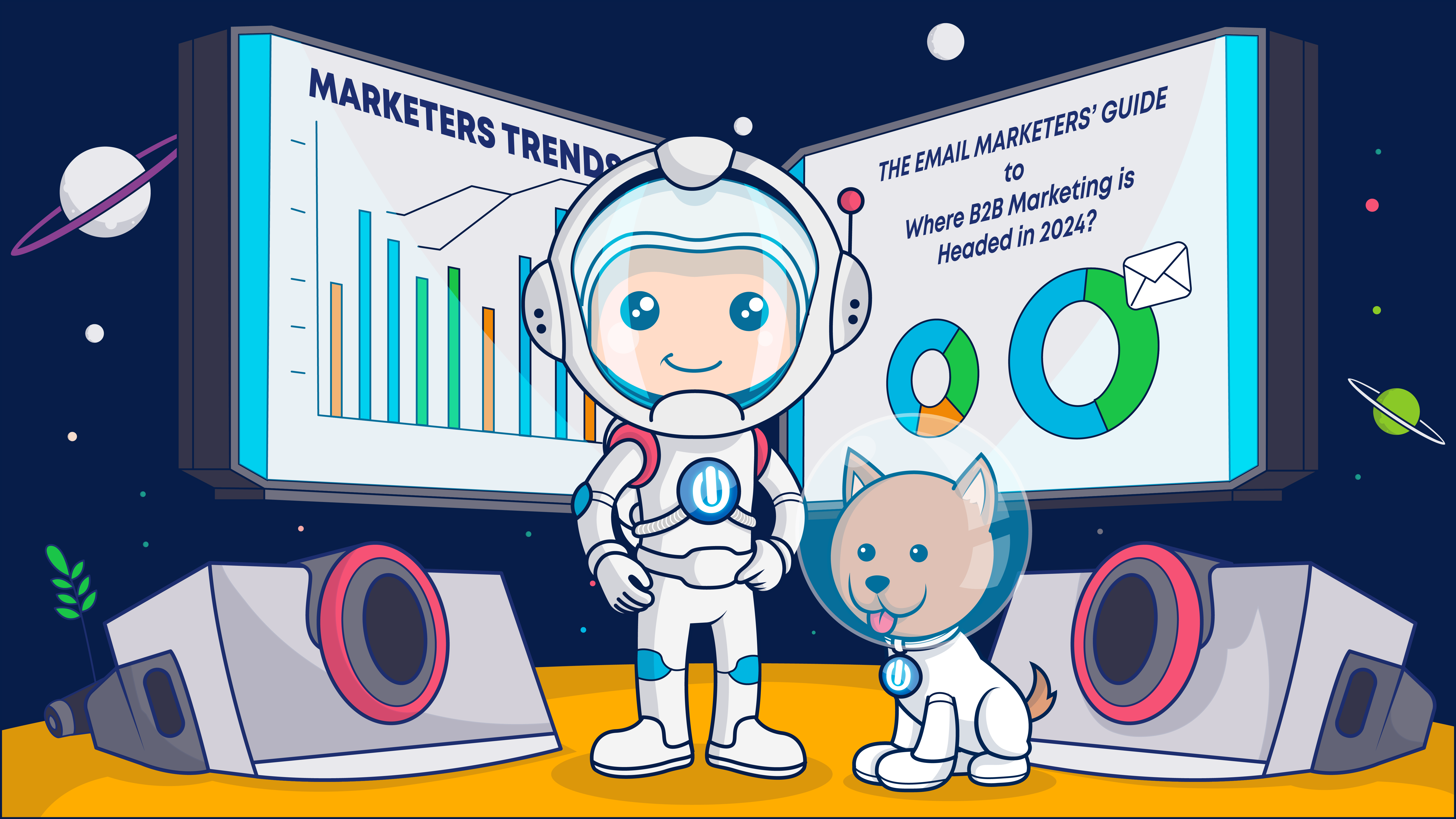Are you ready to increase your revenue in 2024? The path to purchase for B2B buyers isn’t what it used to be. Buyer’s journeys are non-linear and decision makers want new ways to explore and share research. B2B purchasers want self-service options and experiences that resemble their B2C journeys, including personalized, contextual information. Discover the latest trends in B2B marketing to close out the year strong and guide your 2024 email marketing campaigns in this piece.
Marketers always need to be 10 steps (or 6 months) ahead. Maybe even more depending on your buying and production cycles. In 2023, marketing priorities for many B2B organizations have shifted from growth to revenue. Along with every other department, B2B marketing teams were asked to maximize efficiency and deliver near-term revenue.
That’s not a small ask as B2B buyers carefully scrutinize new and existing vendors across an array of metrics and customer loyalty is scarce.
Friends, what I’m trying to say is, “It’s rough out there!”
But, hey, knowledge is power, right?
Let me share the knowledge I’ve gained by examining the latest reports on B2B buying trends and my experience as an email marketer to transform these marketing shifts and challenges into opportunities you can exploit for your brand this year and next.
What is going on out there? The state of B2B buying in 2023
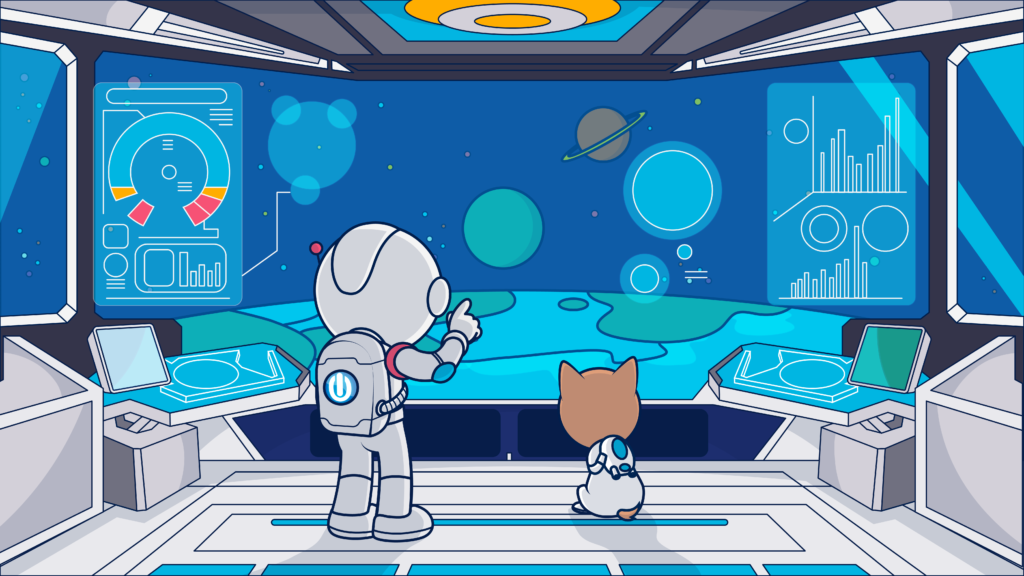
Businesses today are facing pressure on multiple fronts. Higher interest rates, supply chain issues, regulatory changes related to data privacy, ESG practices and disclosures, and shifting workforce priorities all consume attention and resources.
At the same time, purchasing processes have become more collaborative. Team members from different departments and organizational levels are tasked with gathering information, offering feedback and influencing purchase decisions. They may share information across internal communication apps such as project and product management tool Monday or team comms platform Slack.
Successful B2B marketers have to find ways to cut through the noise and communicate with these diverse audiences with the right message at the right time.
And they need to deliver what B2B buyers expect, fast.
But don’t just take my word for it.
Here are the top trends that affected B2B marketing in 2023 (and the statistics that back them).
B2B purchasers want greater control over their path to purchase.
Today’s business purchaser wants to discover information about products or services on their terms and timeline.
- There’s a strong demand for self-service options that facilitate independent research among B2B buyers. This interest is pushing many B2B sellers to engage in attraction marketing methods that draw prospects to them rather than rely on outbound methods for gaining leads.
Among buyers responding to a survey performed by TrustRadius in 2022 which asked what self-service features they’d like to see on vendors’ websites,
- 81% said they wanted to be able to find pricing,
- 72% wanted to view product specs,
- 64% wanted access to demos or free trials, and
- 53% wanted to view customer use cases.
Other research indicates that B2B buyers value interacting with sales reps who can guide them with unique insights and expertise. But they don’t always want that interaction to take place before they’ve had time to explore on their own.
Making demos or free trials, pricing information, and customer reviews available on your website increases the likelihood that B2B purchasers will buy from your brand.
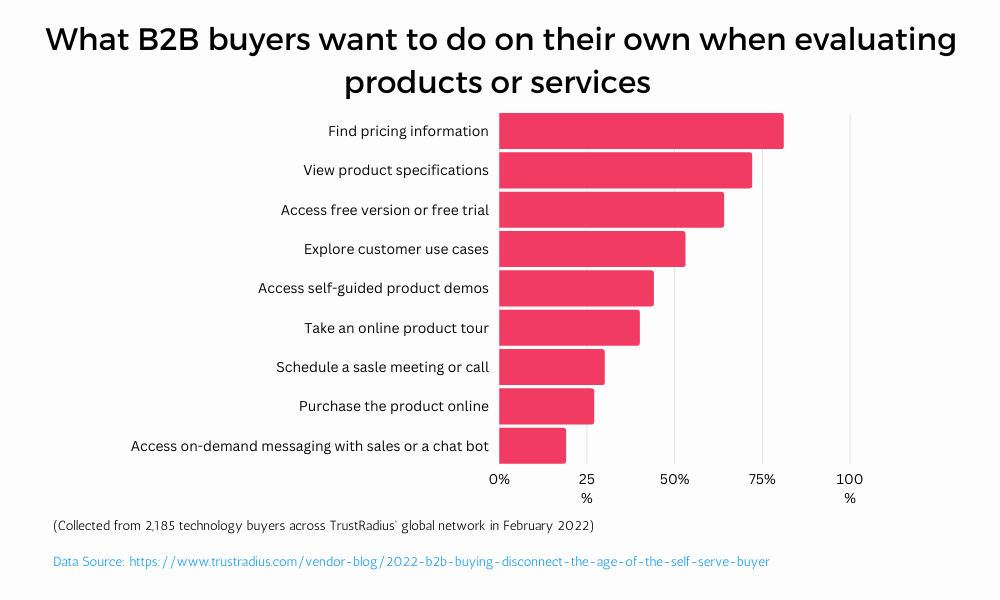
- Many business buyers want a shorter path to purchase. Calling the concept, “compressed commerce,” in its B2B Future Shopper Report 2023, Wunderman Thompson notes that 81% of global B2B shoppers want the interval between inspiration and purchase to be as short as possible.
Requiring multiple steps to access a demo or speak to a sales rep who is qualified to answer crucial questions is a deal-breaker for a growing number of B2B buyers.
Buying teams want ways to easily evaluate and share information.
Many B2B purchases are handled by committees or buying groups that may include a mix of end users, technical experts, and other influencers and decision-makers.
- 60% of organizations responding to Demand Gen Report’s 2022 Buyer Behavior Survey said that their B2B buying group had four or more members.
How do team members exchange information?
- Email is the favorite method for sharing information throughout the buying process among team members according to 68% of B2B buyers responding to TrustRadius’ 2022 survey.
- The top channels used by participants in Demand Gen Report’s 2023 Content Preferences Survey to share information among purchasing group members were LinkedIn (73%) and email (72%).
Making the process of data sharing as frictionless as possible increases the chances of gaining brand champions (and the chances that those brand champions will advocate for your product or service successfully).
Enhance your ability to meet your B2B buyers where they are by using tracking analytics to discover when and how they are sharing your content.
The B2B buyer’s journey gets personal.
It may be a business that is paying the bill, but the decision to buy is made by individuals. Those individuals, working alone or together, bring to their B2B purchasing decisions all of their personal experiences and expectations.
In particular, these influencers and decision-makers bring their B2C purchasing experiences and expectations with them on their B2B buying journey.
- 66% of respondents in the Wunderman Thompson B2B Future Shoppers Report 2023 said they want their journeys to mirror their B2C shopping experiences.
This merger of experiences that started before the pandemic intensified as formerly in-person sales processes went online. Deloitte reports that 67% of the B2B buyer journey now takes place online.
What’s at stake for businesses that don’t deliver a consumer-like experience to their B2B purchasers?
Lost customers and missed revenue goals.
Financial news source PYMNTS reports that 67% of all B2B buyers have switched vendors to gain a more consumer-like experience. Among Millennial B2B buyers, the rate of change reached 74%.
While we’re talking about personal experiences, that’s one of the B2C characteristics that business buyers want from vendors.
They want personalized journeys with communications and interactions that address their specific needs and their business’s distinct pain points across their entire customer lifecycle.
B2C sellers have been leading the way in developing ways to leverage technology to hyper-personalize their customer experiences. Their experimentation can speed your path to successful adoption of these critical strategies. Study what works and trial some of the top tactics with your B2B audiences.
B2B buyers are looking beyond price and availability when choosing vendors and partners.
Another area in which B2C preferences are beginning to influence B2B buying behaviors is sentiment. Few businesses are going to make purchase decisions solely based on how another company makes them feel.
However, the Wunderman Thompson report indicates that 66% of global B2B buyers are more likely to purchase from a company that inspires them by helping them discover new things and bringing them new ideas or suggestions.
- 66% of buyers told Wunderman Thompson that they prioritized the service and customer experience a company delivered more when doing business with a particular brand.
This preference may explain why B2B buyers report favoring brands that produce highly informative, relevant content, including thought leadership and businesses whose sales teams demonstrate deep knowledge of the buyer’s company and industry.
B2B buyers want to be heard and understood.
Vendors’ ESG practices also matter to buyers. The same Wunderman Thompson Future Shopper Report reveals that 69% of B2B buyers want more information about the carbon impact of their purchases.
Unlike individual consumers, values-based purchasing isn’t solely a personal issue for business buyers. Organizations are answerable to internal and external stakeholders including regulatory agencies, watchdog groups, employees, board members, investors and customers.
Organizations inherit ESG risk from any third party with which they do business, explains Marion Jones, in an article for Risk Management Magazine.
- 90% of S&P 500-indexed companies publish sustainability reports currently, and 78% of business executives believe that ESG reporting will be mandatory in the next decade, Jones notes in the article.
Today’s B2B buyers must consider whether a chosen vendor can meet their organization’s sustainability, fair business practices, data privacy, and other standards.
💡 Read about how consumer attitudes are changing the way B2C brands marketing products and services and see examples of sustainable and purpose-driven email marketing campaigns in the article, Reaching the conscious consumer with sustainable email marketing campaigns.
B2B purchasers value opinions from third-party sources at every stage in the buying journey.
The majority of B2B purchase journeys begin online and while vendors’ websites and other points of contact are part of that journey, third-party sources play a pivotal role in setting buyers’ courses.
Industry analysts, trade associations, and discussions with peers and colleagues were among the top sources of information for B2B software buyers during the consideration phase according to Gartner’s 2023 Global Software Buying Trends report.
This report also found that 41% of buyers selected customer reviews and ratings as one of the top five types of content they used to guide their decision. Ratings and reviews content slightly edged out personalized product demonstrations which were selected by 40% of respondents.
Altogether, the Gartner report found that 86% of businesses considered verified reviews important or very important to their software purchase decision.
Similarly, TrustRadius’ 2022 B2B Buying Report reveals that reviews and other third-party information sources can significantly impact purchasing decisions.
| Where B2B buyers looked for information about products, services and vendors in 2023 Vendors’ websites and apps Vendors’ sales and customer support teams User reviews and testimonials Third-party rating and review sites Analysts rankings and reports Communities and forums Trade and industry magazines or publications Peer referrals and recommendations Consultant reviews and recommendations Social media posts and discussions Trade shows, conferences and events |
Want to get a quick overview of what people are saying about your brand?
Enable the beta features in ChatGPT 4, add a plugin that allows it to browse web content, and point it toward select review sites to search for mentions of your brand.
Of course, there are existing tools that will keep an eye on your brand mentions across the internet. But this method can give you a quick peek. You can even set this process on automatic by instructing ChatGPT or a similar generative AI tool to repeat the review at regular intervals.
B2B sellers are expanding the ways in which they communicate with prospects.
As self-directed discovery gains traction, businesses are providing prospective customers with more ways to learn about their products and services. Personal contact with sales reps remains an important component of many businesses’ revenue path.
Other channels include webinars, short-form videos hosted on the business’s website, social media or third-party sites, long- and short-form content such as blogs, case studies, white papers and sales collateral. Virtual and in-person events including trade shows and conferences, and marketplaces are also a part of this mix.
Email and social media, plus vendors’ websites and apps are top channels for businesses to engage with their customers and prospects.
All these channels offer businesses many opportunities to connect with qualified buyers. The real challenge lies in connecting at the right moment and with the right message.
Coordinated cross-channel marketing campaigns help ensure reach and consistency. Meanwhile, email marketing empowers B2B brands to engage with their audience and gather illuminating behavioral and intent data throughout their buyer’s journey using triggered messages and bulk campaigns.
In the next section, I’ll share my best tips for maximizing your B2B email marketing campaign performance.
B2B email marketing best practices for 2024: How to adapt your email campaigns to increase conversions and revenue
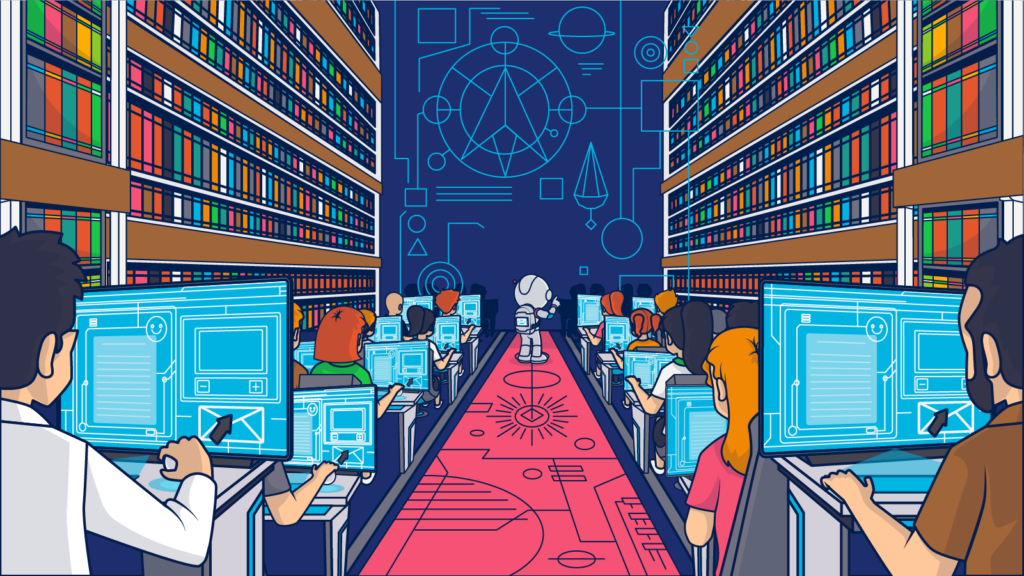
Sending permission-based emails to individual business purchasers or buying group members keeps your business top of mind when these influencers and decision makers before, during and after they contemplate a purchasing decision. Through segmentation, dynamic content and automation, you can make connections that are targeted, personalized and timely.
Your B2B email marketing campaigns facilitate two-way conversations with prospects who’ve already signaled their desire to learn more about your business, nurture leads that need more information to evaluate and share and deliver post-purchase experiences that support successful adoption of your products and services, as well as upsells, cross sells and brand advocacy.
These are just a few of the reasons email remains a top channel for B2B marketing.
How should you employ email marketing as part of your B2B growth strategy now and in 2024?
Check out this list. ⬇️
- Start with a B2B email marketing strategy that aligns with your organization’s business objectives.
Revenue expansion and ROI are taking leading roles in many businesses’ 2023 marketing plans. As you map your email marketing strategy for the second half of 2023 and into 2024, review your organization’s objectives and your department’s marketing constraints.
Aim for a balance between nurturing B2B subscribers who are ready to make a purchase and converting those who have entered the evaluation stage when allocating your campaign resources.
Of course, don’t overlook the importance of customer retention.
The move to digital interactions and current economic conditions have increased the rate at which B2B buyers are switching their suppliers and providers. Use churn analysis to identify weaknesses in your customer retention strategy that an email campaign might remedy.
The move to digital interactions and current economic conditions have increased the rate at which B2B buyers are switching their suppliers and providers. Use churn analysis to identify weaknesses in your customer retention strategy that an email campaign might be able to remedy.
- Increase the quality of leads entering your pipeline by using your email subscription lead magnets and sign up forms to target your ideal customers.
Several times a month, I receive an email from someone representing a company for which I’m not a good lead. I understand. It happens.
But you can reduce how often it happens to your team by creating email capture assets that attract your ideal customer. Use your sign up forms and offers to segment and learn about your new leads, too. Check out The Ultimate Guide To Sign-up Forms for tips, tactics and examples of sign-up forms that get it right.
For example, if your sales team wants to connect with technical influencers in the buying group, offer a white paper or technical buying guide to encourage email sign-ups. Then, use your CRM or other data management system to track which lead magnet attracted a particular subscriber so that you can send appropriate content.
Whenever possible, gain reliable, actionable data about your new subscribers without adding friction to their sign-up process by observing and recording behavioral and other signals.
But also keep in mind that a little added friction may help you screen out buyers with low intent.
Should your sign-up form exclude non-business emails as a screening measure?
Using business addresses only will help you keep track of buying groups for your account based marketing activities. And it may also prevent some spam bot entries.
But you might also miss out on some subscribers who prefer to use a personal address.
I recommend looking at your historical data or performing multivariate testing to determine how restricting address types affects your ultimate conversion rates.
- After sign-up, use your email campaigns to collect more data about your subscribers.
The way your B2B subscribers interact or don’t interact with your emails and other touchpoints can provide valuable intelligence about their journey stage and degree of purchase intent.
Supplement first-party behavioral and system data with direct, zero-party data by sending subscribers interactive content such as quizzes or open-ended questions. I’ve put together a complete list of best practices and methods for collecting subscriber data to help you get started.
Tap into the collective knowledge of third-party sources to enhance your subscriber data and develop a fuller picture of your business subscribers and their needs. These external resources can also help you score these leads and assess their intent.
- Use your data management system to coordinate communications with different members in a buying group or organization.
Avoid sending every member of a buying group the same information by using tagging systems which identify their employer, department and division. Integrate your marketing, sales and customer success data so that your triggered email campaigns are based on the most up-to-date information about each subscriber.
- Update and validate your B2B subscriber lists often.
Subscriber churn happens for a lot of different reasons. So list hygiene is essential for every email marketing program. But it’s especially important for B2B email marketers.
As of January 2022, the median tenure for US employees was 4.1 years according to a US Bureau of Labor Statistics report. When someone changes their job, their email address changes, too.
Okay, maybe 4 years doesn’t seem so bad. But that was last year. As layoffs increase, so will the rate at which business email addresses change. Plus, your B2B subscribers may get a new email when they change departments or roles, too.
Follow the steps in our 2023 email list management guide to avoid bounces and missed opportunities by keeping your B2B email lists fresh and clean.
- Use subscriber data to segment your audiences by personas, buying stage and other business-relevant criteria.
Many of the surveys I reference earlier in this article noted buyers want different content at varying stages in their journey.
For example, discovery stage buyers may be interested in general use cases and webinars that present an overview of the problems your offer solves. In contrast, bottom of the funnel buyers are ready to see exactly how your product’s or service’s features will solve their unique problems and view related case studies.
On your side of the equation, segmentation can help you identify your most high-value prospects and place them on the VIP track for further nurturing.
- Use data and dynamic content to build personalized email messages for your B2B audiences.
Sending mass emails that include the individual recipient’s name is commonplace. There’s no reason your B2B brand can’t provide this level of personalization when communicating with your subscribers.
You can do better than this basic approach.
Use the information your business subscribers share with you to customize their emails by referencing their industry or role in their organization and sending them content and product recommendations that are relevant to them.
- Adding the subscriber’s job function or title to your email subject line can increase open rates by 34% and adding a company name raises opens by 28%, Jay Schwedelson told attendees of the Do This, Not That! Q2 Email Marketing Tips! virtual event which took place in May.
- Engage your B2B buyers at the right moment with the right message with behavior triggered automated emails.
Today’s B2B buyers have access to ample resources about how to solve general problems and address their business needs. What they want from vendors is something more. They want waypoints that guide them toward the solution that is best for their organization’s specific needs.
Your triggered emails are those waypoints, arriving at the moment of need, addressing the issues on your buyers’ minds and offering personalized solutions.
- Make B2B email marketing part of a multichannel journey that nurtures relationships and closes deals.
Email marketing is a powerful tool for maintaining contact with prospects and customers throughout their buyer’s journey. However, as business decision makers and influencers progress toward purchase, they seek information and decision validation from online and offline sources.
Modern B2B sellers can’t afford to ignore the channels where buyers are looking for answers. Coordinate your email marketing campaigns with your other communication channels to create a seamless experience for buyers.
In addition to using email newsletters to keep your B2B subscribers informed and engaged, create targeted, automated campaigns initiated by website visits or interactions with your organization’s sales or customer service teams that keep the conversation going and move your B2B buyers forward on their journey.
Audit all of your campaigns regularly to ensure there are no gaps and that your message is consistent across all channels.
- Craft email messages that appeal to logic and emotion.
Business purchasers want products and services that are reliable and cost effective. They’ll look for information such as case studies, price and feature comparisons, return policies and other details that justify choosing your brand.
But solely appealing to logic may not capture the attention or imagination of your prospect or provide your internal supporters with the tools they need to persuade their buying group.
Use your emails to craft a narrative that enables buyers with varying degrees of knowledge and sophistication to envision the benefits your solution delivers. Communicate the use cases for your products and services and the goals and aspirations they’ll help your customers fulfill.
Show your prospects how choosing your product or service will lead to professional and organizational success through both words and images.
- Make your B2B email marketing content easily consumable and shareable.
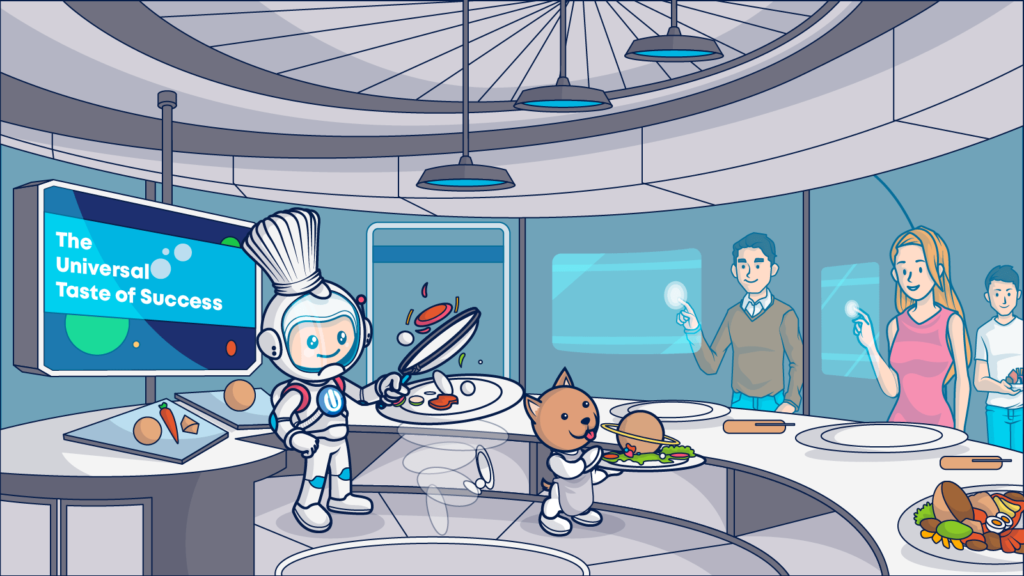
When decisions are made by committee, communicating clearly and persuasively is critical. Provide your subscribers with bite-sized pieces of information that clarify key points and are easily shareable.
Send webinar invites that your subscribers can forward to other team members. Create emails that answer frequently asked questions or illustrate your product or services top benefits and features.
Use your email campaigns to help your buyers collaborate more efficiently.
- Gather (and share) feedback and testimonials via B2B email campaigns.
Every survey of B2B buying patterns I reviewed emphasized the importance of rating and reviews as a decision driver. Don’t rely on third-party platforms to generate these reviews for you.
Actively seek online reviews and testimonials about your products or services through post-purchase email campaigns.
Get useful feedback and increase your total number of reviews by reaching out to your engaged subscribers and encouraging them to share their opinions with you and on independent review websites.
Invite your satisfied customers to provide testimonials and take part in case studies through targeted email campaigns.
If you don’t have many reviews or case studies for one or more customer subsets, use segmentation to target those customer groups. For instance, you might seek reviews from customers in regions where you’d like to expand or businesses operating in specific industries.
How will you use B2B email marketing in 2024?
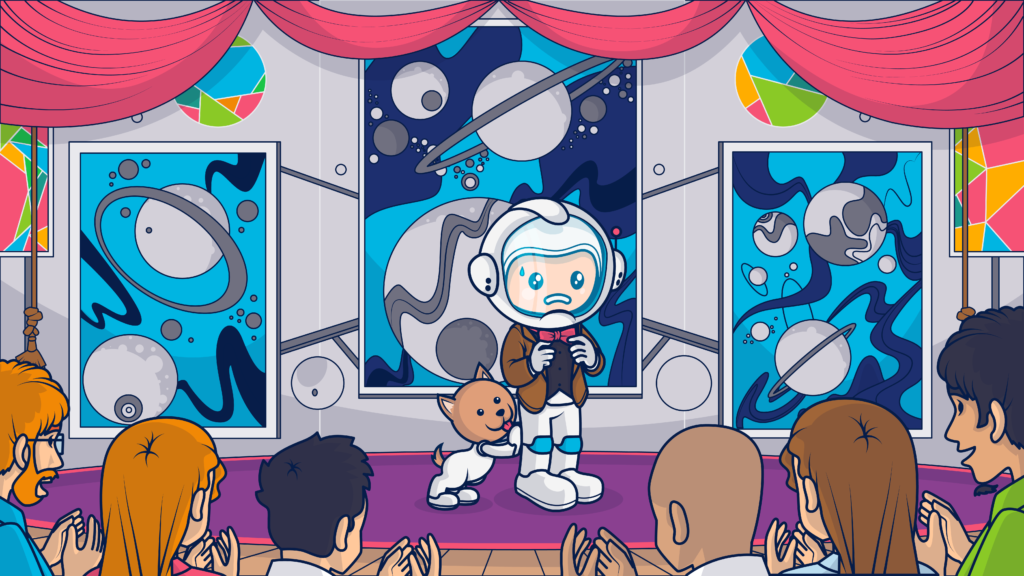
As buyer expectations and business objectives change, your email marketing program remains a reliable, controllable channel for your B2B business. Use your B2B email marketing campaigns to deliver value-adding, relevant content to your leads and customers. Strengthen your relationships, introduce new products and keep your buyers moving forward on their path to purchase through your newsletters and targeted campaigns.
Don’t be afraid to experiment and show a little personality, either. Your B2B customers want to know about your business and the people behind it. Check out our article, Video Email Marketing: Tips, Strategies, and Examples, for some awesome advice on showing your customers your products, services, and your brand personality using video!

